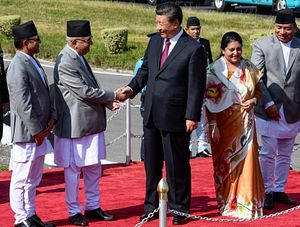Last week, as expected, Chinese President Xi Jinping stopped in Kathmandu, the capital of Nepal, for a state visit on his way back to China after an informal summit with the Indian Prime Minister Narendra Modi.
Xi’s Nepal trip itself came as no surprise: China has been attempting to woo India’s smaller neighbors in South Asia, and there is clearly interest among some including Nepal to use the Sino-Indian competition for their own benefits. But Xi’s trip also showed the limits of these converging interests. Indeed, the lack of progress on issues, with an extradition agreement not signed being a case in point, reinforces the fact that any alignment has its limits despite the strategic interests that both Nepal and China see in the wider relationship.
The mutual attraction between Nepal and China is easy enough to understand. From Beijing’s perspective, Nepal is important for a few strategic reasons. For one, Nepal borders China’s Tibet Autonomous Region (TAR). Though Tibet is relatively quiet, China always worries about the possibility of a resurgence of Tibetan nationalism. Though the largest chunk of Tibetan refugees lives in India, Nepal also hosts about 20,000 Tibetan exiles. Any disturbance in Tibet will likely have some reverberations in Nepal too.
Thus, China is concerned about ensuring that the Tibetan exile population in Nepal does not become an issue of concern. This appears to have been the primary reason why China was pushing for an extradition treaty with Nepal. This also makes good relations with Nepal an important means of managing any future problems in Tibet itself.
In addition to this direct linkage, China also has more general and obvious balance of power considerations in befriending Nepal. As a small South Asian neighbor of India, Nepal affords the opportunity to balance India within the region itself. Nepal’s relations with India, which had its ups and downs, makes Kathmandu a potentially attractive partner for Beijing. There is nothing unusual in this because this is at least part of the reason for Beijing’s outreach to all of India’s smaller neighbors. And of course, India returns the favor, trying to partner with China’s own smaller neighbors such as Vietnam.
A third reason for China’s interests in Nepal is China’s drive to develop the Belt and Road scheme, both as a means of exporting Chinese capital and labor but also expanding its interests. China has discussed several BRI projects with Nepal, including a railroad that would link Lhasa and Kathmandu as well as a Parliament building, National Defence University, and other infrastructure projects.
Nepal also has some interest in developing this partnership with China. For one, a closer relationship with China makes India a lot more receptive to Nepali concerns. Nepal, like India’s other neighbors, has complaints about the lackadaisical manner in which New Delhi approaches development projects in Nepal. Chinese help with infrastructure kills two birds with one stone. It potentially helps Nepal develop economic infrastructure – China has been very efficient in completing such projects, especially in comparison to India – while also putting pressure on India to pay greater attention to Nepali connectivity requirements. Seen from this perspective, having two great powers competing for Nepal’s attention will not be entirely unwelcome in Kathmandu.
In addition, Nepal, a small, landlocked country, also feels vulnerable to Indian pressures. India has been known to impose blockades on Nepal because much of Nepal’s international trade either originates in India or passes through Indian territory. The most recent of these blockades was in 2015, when India imposed an unofficial blockade in an ill-advised move to pressure Kathmandu over what was perceived by India to be discrimination against the Madhesi population in the new Nepali constitution. Though it appears somewhat impractical, Nepal would like to reduce its dependence on India by building trade and transit linkages through China. At the very least, closer linkages with China might make India more careful antagonizing Nepal.
But the strategic interests both sides have for better ties does not mean that there are not limits and challenges for relations. Indeed, if anything, Xi’s visit to Nepal, which saw the relative lack of substantive outcomes despite the hype, reinforced this reality. Despite the seeming attractiveness of the China partnership, there appears to be some disquiet within sections of the Nepali elite about getting too close to China as well as other dangers such as the potential debt-trap by way of involvement in the BRI. India’s unwillingness is also possibly an issue, because as Constantino Xavier, a close observer of India’s relations with its neighbors, has pointed out, one of the projects was meant to be a Sino-Nepalese-Indian, which India is now reluctant to pursue.
All this suggests that mutual interests by itself may not be sufficient to power China-Nepal relations. Negotiating the terms of actual deals, domestic national concerns, as well as the fear of getting dragged into the Sino-Indian competition, are all likely to limit how close India’s neighbors such as Nepal will get to China.

































